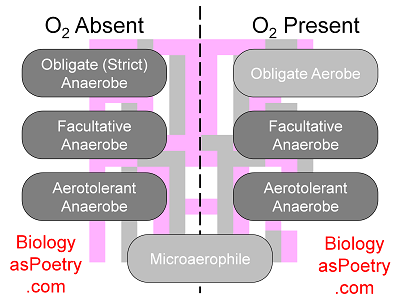∞ generated and posted on 2016.08.25 ∞
Absence of molecular oxygen.
Anaerobic metabolism by an organism – that is, as displayed by organisms that can be described as anaerobes – is an ability to function, particular to generate ATP, without employing oxygen (O2) as a final electron acceptor for cellular respiration (in the course of oxidative phosphorylation).
These organisms, that is, are "born", can grow, and reproduce without "breathing" or otherwise obtaining air, though some anaerobes can use oxygen when it is available, i.e., so-called facultative anaerobes. See also aerotolerant anaerobe and strict or obligate anaerobe.

Figure legend: Anaerobes – organisms that can continue to metabolize, replicate, and grow despite an absence of molecular oxygen – come in a variety of types. Strict anaerobes cannot do any of the above in the presence of oxygen. 'Obligate' is often used a synonym for strict. An aerotolerant anaerobe is equivalent to an obligate anaerobe except that these organisms are able to survive and replicate, etc., despite the presence of molecular oxygen. With aerotolerant anaerobes, however, the oxygen is neither helpful nor harmful. Facultative anaerobes, on the other hand, are able to utilize molecular oxygen, switching their metabolisms from generally fermentative absent molecular oxygen to cellular respiration in its presence. Note that even certain obligate aerobes are able to replicate under anaerobic conditions, though displaying strictly anaerobic respiration rather than fermentation.
Most anaerobic organisms that most people are familiar with employ fermentation pathways to regenerated NAD+ anaerobically for use in glycolysis. Among those organisms are ourselves in our muscle cells during "anaerobic" exercise. Other organisms exist, however, which are able to display cellular respiration in the absence of oxygen, so-called anaerobic respiration